Analysis of Project Management Issues, Challenges, and Solutions
VerifiedAdded on 2020/03/07
|16
|6709
|110
Report
AI Summary
This report delves into the critical issues and challenges within project management, aiming to understand the factors contributing to project failures and propose effective solutions. It begins by highlighting the significance of project management and the prevalence of project failures, especially in IT projects. The report then explores various problems and research objectives, including identifying critical failure factors and analyzing case studies of impaired and challenged projects. It covers the methodology used, including data collection and case study analysis, examining specific project failures like Kmart's supply chain system and McDonald's Innovate system. The discussion section synthesizes findings, while the conclusion and recommendations offer insights into overcoming project challenges. The report also reviews current knowledge and theoretical gaps, including theories like agency theory and attribution theory, and explores early warning signs of project failure. The report emphasizes the importance of understanding failure factors at each stage of project management and proposes solutions to mitigate risks and enhance project success.
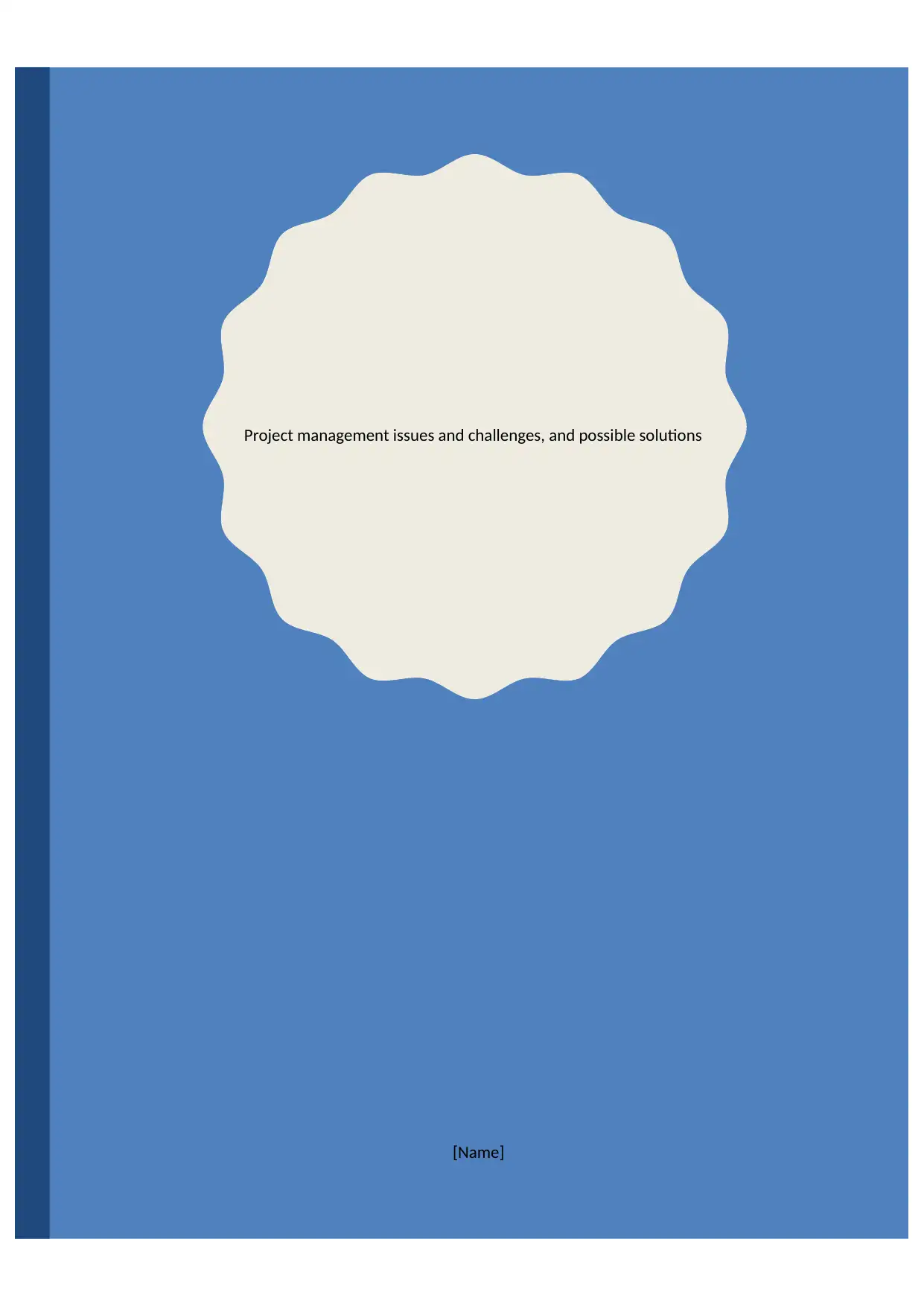
Project management issues and challenges, and possible solutions
[Name]
[Name]
Paraphrase This Document
Need a fresh take? Get an instant paraphrase of this document with our AI Paraphraser
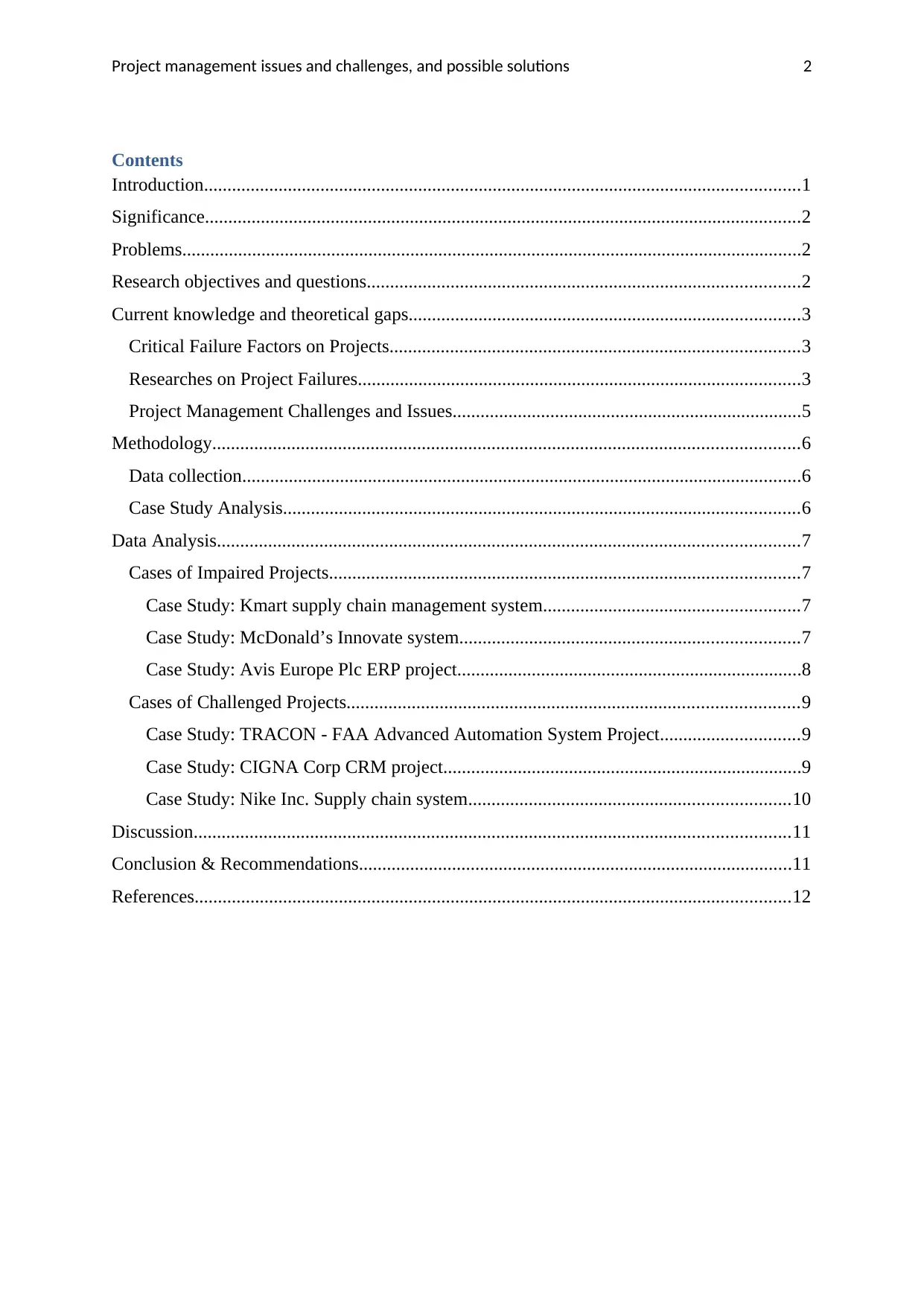
Project management issues and challenges, and possible solutions
Contents
Introduction................................................................................................................................1
Significance................................................................................................................................2
Problems.....................................................................................................................................2
Research objectives and questions.............................................................................................2
Current knowledge and theoretical gaps....................................................................................3
Critical Failure Factors on Projects........................................................................................3
Researches on Project Failures...............................................................................................3
Project Management Challenges and Issues...........................................................................5
Methodology..............................................................................................................................6
Data collection........................................................................................................................6
Case Study Analysis...............................................................................................................6
Data Analysis.............................................................................................................................7
Cases of Impaired Projects.....................................................................................................7
Case Study: Kmart supply chain management system.......................................................7
Case Study: McDonald’s Innovate system.........................................................................7
Case Study: Avis Europe Plc ERP project..........................................................................8
Cases of Challenged Projects.................................................................................................9
Case Study: TRACON - FAA Advanced Automation System Project..............................9
Case Study: CIGNA Corp CRM project.............................................................................9
Case Study: Nike Inc. Supply chain system.....................................................................10
Discussion................................................................................................................................11
Conclusion & Recommendations.............................................................................................11
References................................................................................................................................12
2
Contents
Introduction................................................................................................................................1
Significance................................................................................................................................2
Problems.....................................................................................................................................2
Research objectives and questions.............................................................................................2
Current knowledge and theoretical gaps....................................................................................3
Critical Failure Factors on Projects........................................................................................3
Researches on Project Failures...............................................................................................3
Project Management Challenges and Issues...........................................................................5
Methodology..............................................................................................................................6
Data collection........................................................................................................................6
Case Study Analysis...............................................................................................................6
Data Analysis.............................................................................................................................7
Cases of Impaired Projects.....................................................................................................7
Case Study: Kmart supply chain management system.......................................................7
Case Study: McDonald’s Innovate system.........................................................................7
Case Study: Avis Europe Plc ERP project..........................................................................8
Cases of Challenged Projects.................................................................................................9
Case Study: TRACON - FAA Advanced Automation System Project..............................9
Case Study: CIGNA Corp CRM project.............................................................................9
Case Study: Nike Inc. Supply chain system.....................................................................10
Discussion................................................................................................................................11
Conclusion & Recommendations.............................................................................................11
References................................................................................................................................12
2
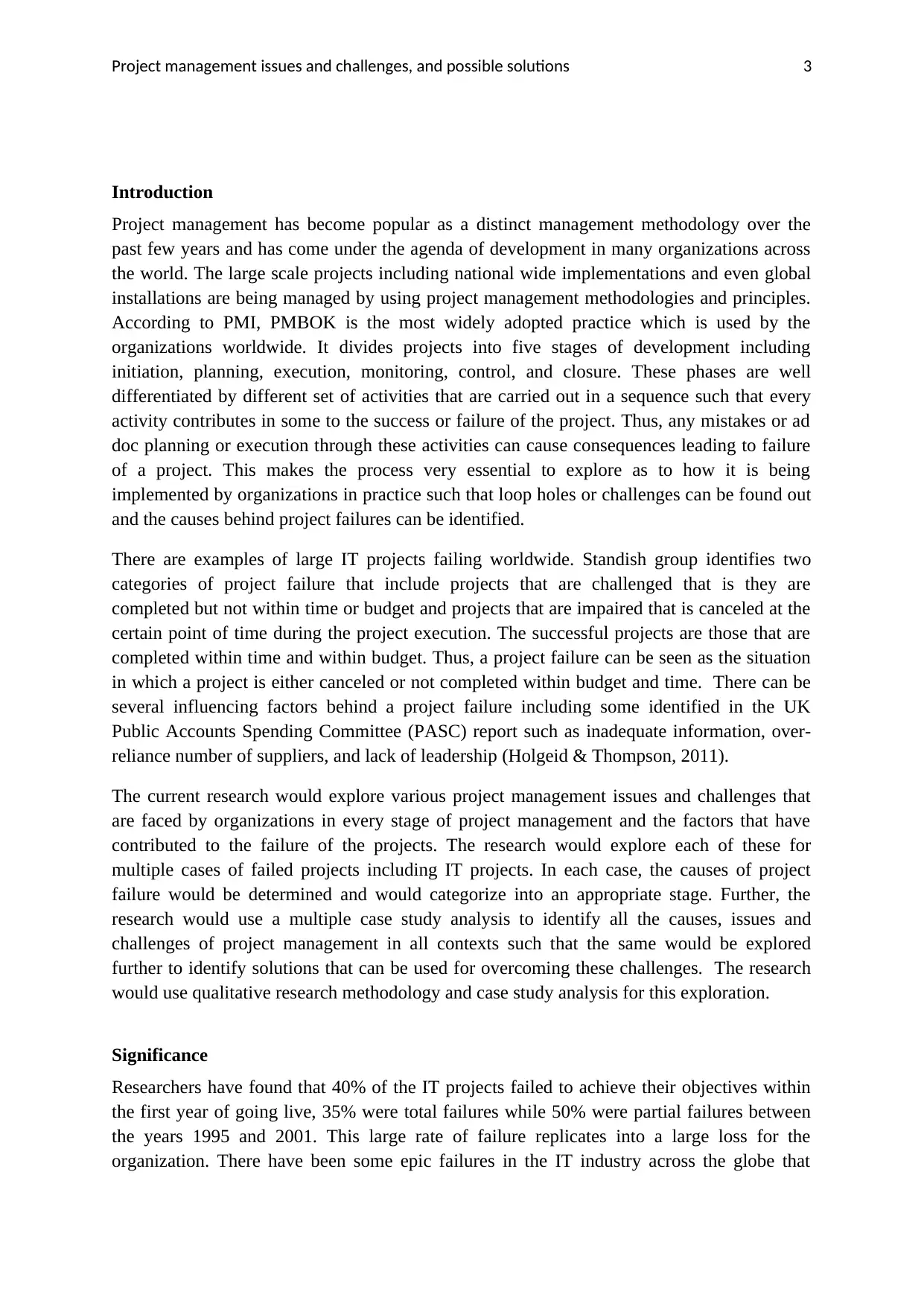
Project management issues and challenges, and possible solutions
Introduction
Project management has become popular as a distinct management methodology over the
past few years and has come under the agenda of development in many organizations across
the world. The large scale projects including national wide implementations and even global
installations are being managed by using project management methodologies and principles.
According to PMI, PMBOK is the most widely adopted practice which is used by the
organizations worldwide. It divides projects into five stages of development including
initiation, planning, execution, monitoring, control, and closure. These phases are well
differentiated by different set of activities that are carried out in a sequence such that every
activity contributes in some to the success or failure of the project. Thus, any mistakes or ad
doc planning or execution through these activities can cause consequences leading to failure
of a project. This makes the process very essential to explore as to how it is being
implemented by organizations in practice such that loop holes or challenges can be found out
and the causes behind project failures can be identified.
There are examples of large IT projects failing worldwide. Standish group identifies two
categories of project failure that include projects that are challenged that is they are
completed but not within time or budget and projects that are impaired that is canceled at the
certain point of time during the project execution. The successful projects are those that are
completed within time and within budget. Thus, a project failure can be seen as the situation
in which a project is either canceled or not completed within budget and time. There can be
several influencing factors behind a project failure including some identified in the UK
Public Accounts Spending Committee (PASC) report such as inadequate information, over-
reliance number of suppliers, and lack of leadership (Holgeid & Thompson, 2011).
The current research would explore various project management issues and challenges that
are faced by organizations in every stage of project management and the factors that have
contributed to the failure of the projects. The research would explore each of these for
multiple cases of failed projects including IT projects. In each case, the causes of project
failure would be determined and would categorize into an appropriate stage. Further, the
research would use a multiple case study analysis to identify all the causes, issues and
challenges of project management in all contexts such that the same would be explored
further to identify solutions that can be used for overcoming these challenges. The research
would use qualitative research methodology and case study analysis for this exploration.
Significance
Researchers have found that 40% of the IT projects failed to achieve their objectives within
the first year of going live, 35% were total failures while 50% were partial failures between
the years 1995 and 2001. This large rate of failure replicates into a large loss for the
organization. There have been some epic failures in the IT industry across the globe that
3
Introduction
Project management has become popular as a distinct management methodology over the
past few years and has come under the agenda of development in many organizations across
the world. The large scale projects including national wide implementations and even global
installations are being managed by using project management methodologies and principles.
According to PMI, PMBOK is the most widely adopted practice which is used by the
organizations worldwide. It divides projects into five stages of development including
initiation, planning, execution, monitoring, control, and closure. These phases are well
differentiated by different set of activities that are carried out in a sequence such that every
activity contributes in some to the success or failure of the project. Thus, any mistakes or ad
doc planning or execution through these activities can cause consequences leading to failure
of a project. This makes the process very essential to explore as to how it is being
implemented by organizations in practice such that loop holes or challenges can be found out
and the causes behind project failures can be identified.
There are examples of large IT projects failing worldwide. Standish group identifies two
categories of project failure that include projects that are challenged that is they are
completed but not within time or budget and projects that are impaired that is canceled at the
certain point of time during the project execution. The successful projects are those that are
completed within time and within budget. Thus, a project failure can be seen as the situation
in which a project is either canceled or not completed within budget and time. There can be
several influencing factors behind a project failure including some identified in the UK
Public Accounts Spending Committee (PASC) report such as inadequate information, over-
reliance number of suppliers, and lack of leadership (Holgeid & Thompson, 2011).
The current research would explore various project management issues and challenges that
are faced by organizations in every stage of project management and the factors that have
contributed to the failure of the projects. The research would explore each of these for
multiple cases of failed projects including IT projects. In each case, the causes of project
failure would be determined and would categorize into an appropriate stage. Further, the
research would use a multiple case study analysis to identify all the causes, issues and
challenges of project management in all contexts such that the same would be explored
further to identify solutions that can be used for overcoming these challenges. The research
would use qualitative research methodology and case study analysis for this exploration.
Significance
Researchers have found that 40% of the IT projects failed to achieve their objectives within
the first year of going live, 35% were total failures while 50% were partial failures between
the years 1995 and 2001. This large rate of failure replicates into a large loss for the
organization. There have been some epic failures in the IT industry across the globe that
3
⊘ This is a preview!⊘
Do you want full access?
Subscribe today to unlock all pages.

Trusted by 1+ million students worldwide
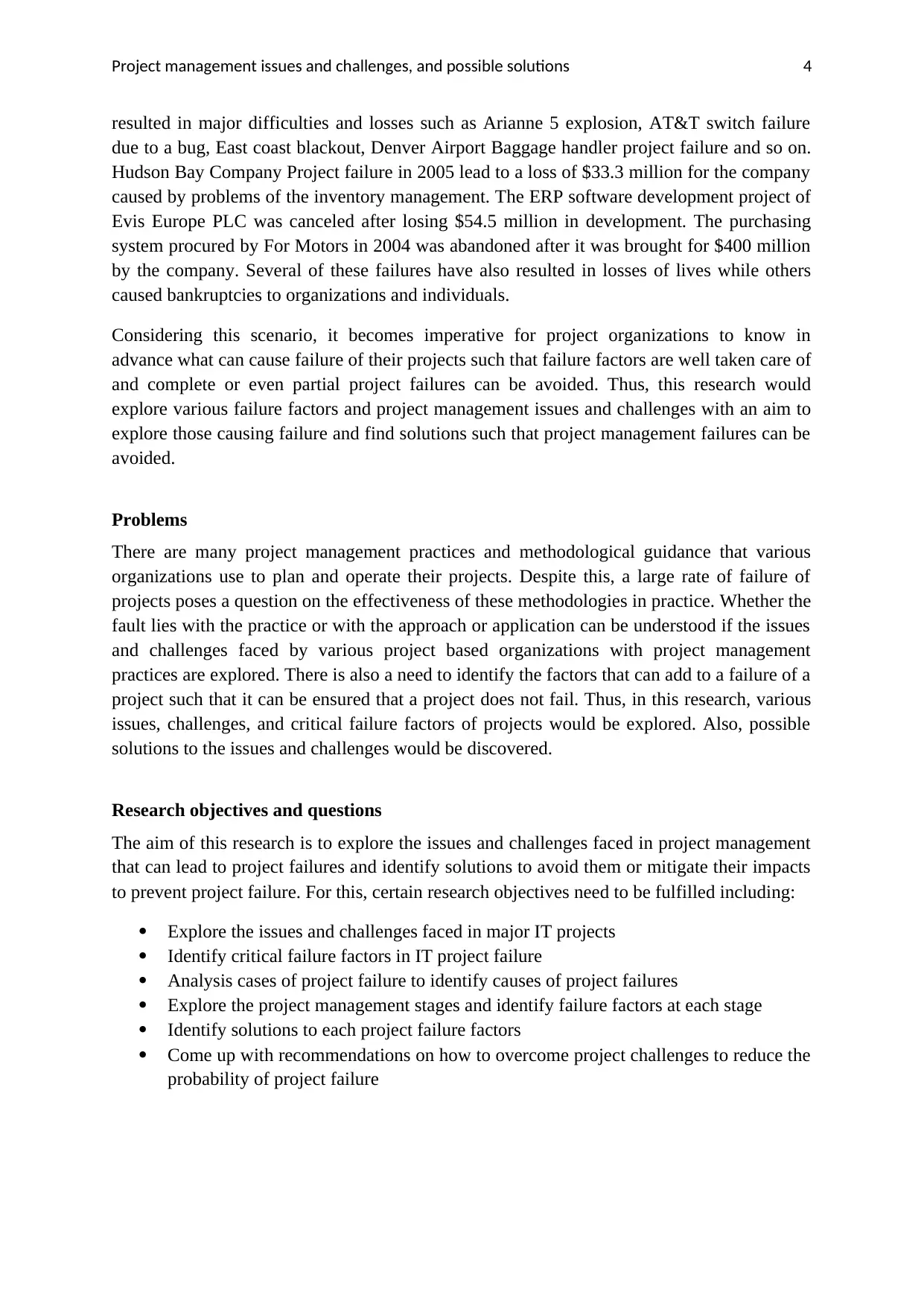
Project management issues and challenges, and possible solutions
resulted in major difficulties and losses such as Arianne 5 explosion, AT&T switch failure
due to a bug, East coast blackout, Denver Airport Baggage handler project failure and so on.
Hudson Bay Company Project failure in 2005 lead to a loss of $33.3 million for the company
caused by problems of the inventory management. The ERP software development project of
Evis Europe PLC was canceled after losing $54.5 million in development. The purchasing
system procured by For Motors in 2004 was abandoned after it was brought for $400 million
by the company. Several of these failures have also resulted in losses of lives while others
caused bankruptcies to organizations and individuals.
Considering this scenario, it becomes imperative for project organizations to know in
advance what can cause failure of their projects such that failure factors are well taken care of
and complete or even partial project failures can be avoided. Thus, this research would
explore various failure factors and project management issues and challenges with an aim to
explore those causing failure and find solutions such that project management failures can be
avoided.
Problems
There are many project management practices and methodological guidance that various
organizations use to plan and operate their projects. Despite this, a large rate of failure of
projects poses a question on the effectiveness of these methodologies in practice. Whether the
fault lies with the practice or with the approach or application can be understood if the issues
and challenges faced by various project based organizations with project management
practices are explored. There is also a need to identify the factors that can add to a failure of a
project such that it can be ensured that a project does not fail. Thus, in this research, various
issues, challenges, and critical failure factors of projects would be explored. Also, possible
solutions to the issues and challenges would be discovered.
Research objectives and questions
The aim of this research is to explore the issues and challenges faced in project management
that can lead to project failures and identify solutions to avoid them or mitigate their impacts
to prevent project failure. For this, certain research objectives need to be fulfilled including:
Explore the issues and challenges faced in major IT projects
Identify critical failure factors in IT project failure
Analysis cases of project failure to identify causes of project failures
Explore the project management stages and identify failure factors at each stage
Identify solutions to each project failure factors
Come up with recommendations on how to overcome project challenges to reduce the
probability of project failure
4
resulted in major difficulties and losses such as Arianne 5 explosion, AT&T switch failure
due to a bug, East coast blackout, Denver Airport Baggage handler project failure and so on.
Hudson Bay Company Project failure in 2005 lead to a loss of $33.3 million for the company
caused by problems of the inventory management. The ERP software development project of
Evis Europe PLC was canceled after losing $54.5 million in development. The purchasing
system procured by For Motors in 2004 was abandoned after it was brought for $400 million
by the company. Several of these failures have also resulted in losses of lives while others
caused bankruptcies to organizations and individuals.
Considering this scenario, it becomes imperative for project organizations to know in
advance what can cause failure of their projects such that failure factors are well taken care of
and complete or even partial project failures can be avoided. Thus, this research would
explore various failure factors and project management issues and challenges with an aim to
explore those causing failure and find solutions such that project management failures can be
avoided.
Problems
There are many project management practices and methodological guidance that various
organizations use to plan and operate their projects. Despite this, a large rate of failure of
projects poses a question on the effectiveness of these methodologies in practice. Whether the
fault lies with the practice or with the approach or application can be understood if the issues
and challenges faced by various project based organizations with project management
practices are explored. There is also a need to identify the factors that can add to a failure of a
project such that it can be ensured that a project does not fail. Thus, in this research, various
issues, challenges, and critical failure factors of projects would be explored. Also, possible
solutions to the issues and challenges would be discovered.
Research objectives and questions
The aim of this research is to explore the issues and challenges faced in project management
that can lead to project failures and identify solutions to avoid them or mitigate their impacts
to prevent project failure. For this, certain research objectives need to be fulfilled including:
Explore the issues and challenges faced in major IT projects
Identify critical failure factors in IT project failure
Analysis cases of project failure to identify causes of project failures
Explore the project management stages and identify failure factors at each stage
Identify solutions to each project failure factors
Come up with recommendations on how to overcome project challenges to reduce the
probability of project failure
4
Paraphrase This Document
Need a fresh take? Get an instant paraphrase of this document with our AI Paraphraser
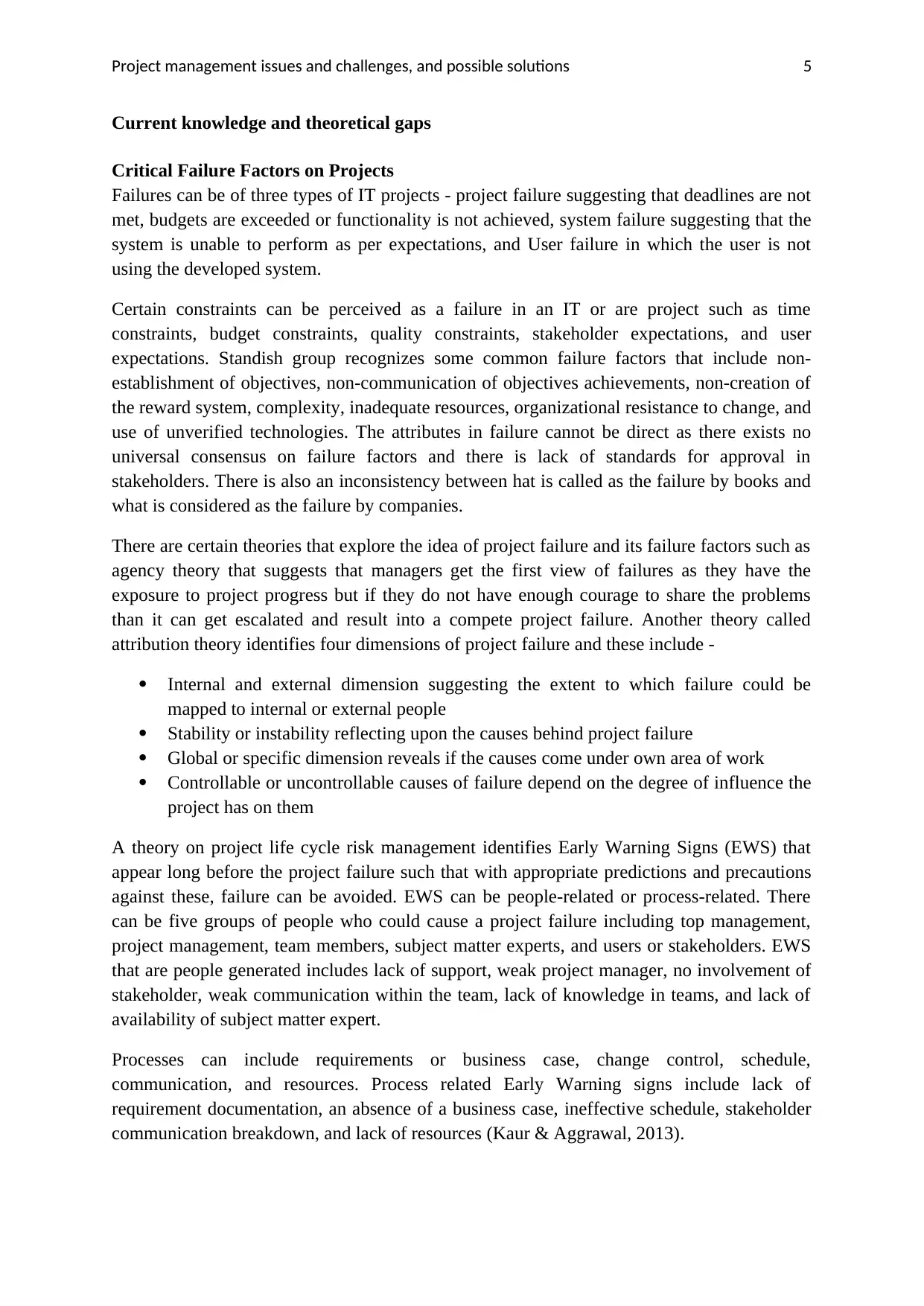
Project management issues and challenges, and possible solutions
Current knowledge and theoretical gaps
Critical Failure Factors on Projects
Failures can be of three types of IT projects - project failure suggesting that deadlines are not
met, budgets are exceeded or functionality is not achieved, system failure suggesting that the
system is unable to perform as per expectations, and User failure in which the user is not
using the developed system.
Certain constraints can be perceived as a failure in an IT or are project such as time
constraints, budget constraints, quality constraints, stakeholder expectations, and user
expectations. Standish group recognizes some common failure factors that include non-
establishment of objectives, non-communication of objectives achievements, non-creation of
the reward system, complexity, inadequate resources, organizational resistance to change, and
use of unverified technologies. The attributes in failure cannot be direct as there exists no
universal consensus on failure factors and there is lack of standards for approval in
stakeholders. There is also an inconsistency between hat is called as the failure by books and
what is considered as the failure by companies.
There are certain theories that explore the idea of project failure and its failure factors such as
agency theory that suggests that managers get the first view of failures as they have the
exposure to project progress but if they do not have enough courage to share the problems
than it can get escalated and result into a compete project failure. Another theory called
attribution theory identifies four dimensions of project failure and these include -
Internal and external dimension suggesting the extent to which failure could be
mapped to internal or external people
Stability or instability reflecting upon the causes behind project failure
Global or specific dimension reveals if the causes come under own area of work
Controllable or uncontrollable causes of failure depend on the degree of influence the
project has on them
A theory on project life cycle risk management identifies Early Warning Signs (EWS) that
appear long before the project failure such that with appropriate predictions and precautions
against these, failure can be avoided. EWS can be people-related or process-related. There
can be five groups of people who could cause a project failure including top management,
project management, team members, subject matter experts, and users or stakeholders. EWS
that are people generated includes lack of support, weak project manager, no involvement of
stakeholder, weak communication within the team, lack of knowledge in teams, and lack of
availability of subject matter expert.
Processes can include requirements or business case, change control, schedule,
communication, and resources. Process related Early Warning signs include lack of
requirement documentation, an absence of a business case, ineffective schedule, stakeholder
communication breakdown, and lack of resources (Kaur & Aggrawal, 2013).
5
Current knowledge and theoretical gaps
Critical Failure Factors on Projects
Failures can be of three types of IT projects - project failure suggesting that deadlines are not
met, budgets are exceeded or functionality is not achieved, system failure suggesting that the
system is unable to perform as per expectations, and User failure in which the user is not
using the developed system.
Certain constraints can be perceived as a failure in an IT or are project such as time
constraints, budget constraints, quality constraints, stakeholder expectations, and user
expectations. Standish group recognizes some common failure factors that include non-
establishment of objectives, non-communication of objectives achievements, non-creation of
the reward system, complexity, inadequate resources, organizational resistance to change, and
use of unverified technologies. The attributes in failure cannot be direct as there exists no
universal consensus on failure factors and there is lack of standards for approval in
stakeholders. There is also an inconsistency between hat is called as the failure by books and
what is considered as the failure by companies.
There are certain theories that explore the idea of project failure and its failure factors such as
agency theory that suggests that managers get the first view of failures as they have the
exposure to project progress but if they do not have enough courage to share the problems
than it can get escalated and result into a compete project failure. Another theory called
attribution theory identifies four dimensions of project failure and these include -
Internal and external dimension suggesting the extent to which failure could be
mapped to internal or external people
Stability or instability reflecting upon the causes behind project failure
Global or specific dimension reveals if the causes come under own area of work
Controllable or uncontrollable causes of failure depend on the degree of influence the
project has on them
A theory on project life cycle risk management identifies Early Warning Signs (EWS) that
appear long before the project failure such that with appropriate predictions and precautions
against these, failure can be avoided. EWS can be people-related or process-related. There
can be five groups of people who could cause a project failure including top management,
project management, team members, subject matter experts, and users or stakeholders. EWS
that are people generated includes lack of support, weak project manager, no involvement of
stakeholder, weak communication within the team, lack of knowledge in teams, and lack of
availability of subject matter expert.
Processes can include requirements or business case, change control, schedule,
communication, and resources. Process related Early Warning signs include lack of
requirement documentation, an absence of a business case, ineffective schedule, stakeholder
communication breakdown, and lack of resources (Kaur & Aggrawal, 2013).
5
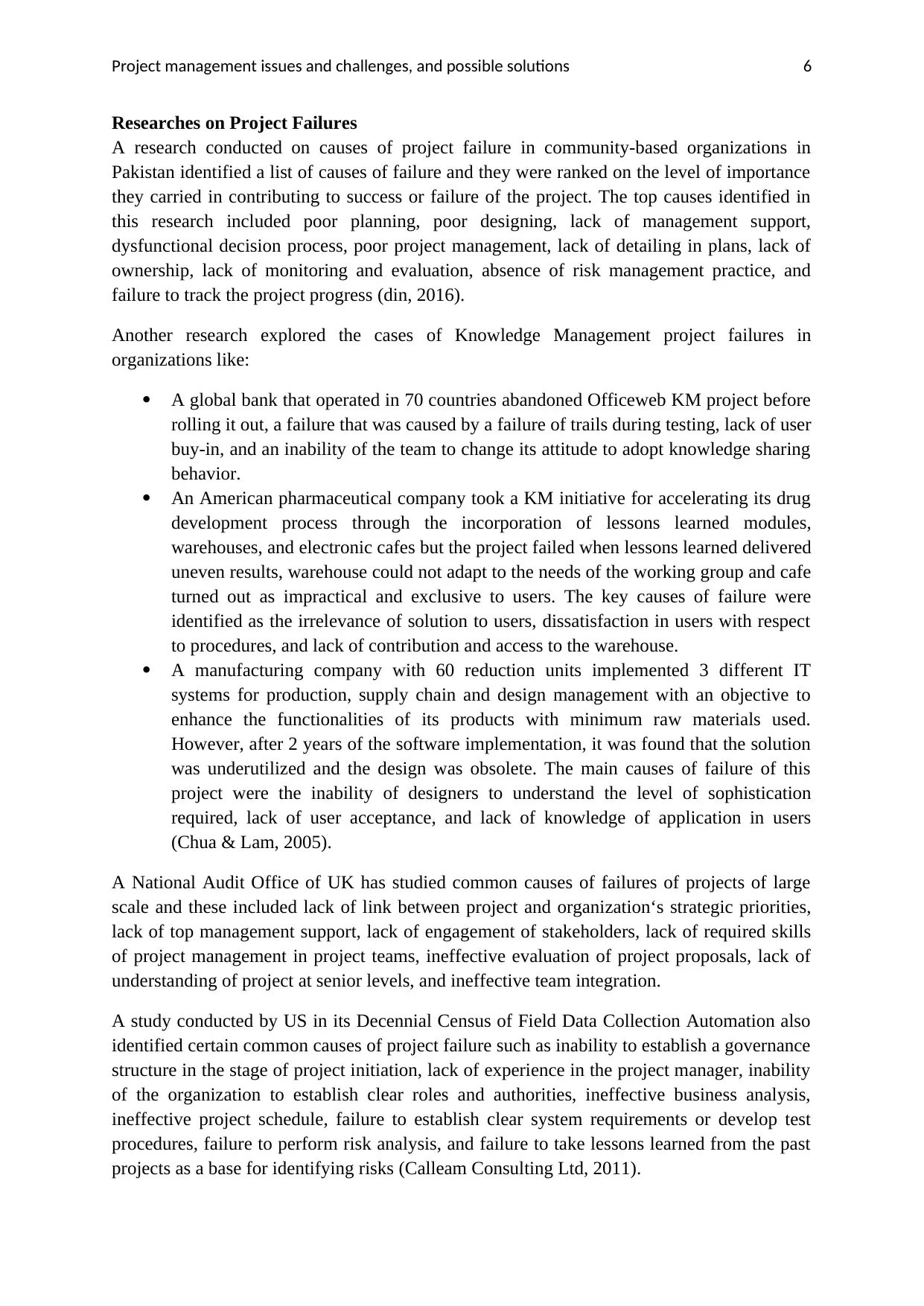
Project management issues and challenges, and possible solutions
Researches on Project Failures
A research conducted on causes of project failure in community-based organizations in
Pakistan identified a list of causes of failure and they were ranked on the level of importance
they carried in contributing to success or failure of the project. The top causes identified in
this research included poor planning, poor designing, lack of management support,
dysfunctional decision process, poor project management, lack of detailing in plans, lack of
ownership, lack of monitoring and evaluation, absence of risk management practice, and
failure to track the project progress (din, 2016).
Another research explored the cases of Knowledge Management project failures in
organizations like:
A global bank that operated in 70 countries abandoned Officeweb KM project before
rolling it out, a failure that was caused by a failure of trails during testing, lack of user
buy-in, and an inability of the team to change its attitude to adopt knowledge sharing
behavior.
An American pharmaceutical company took a KM initiative for accelerating its drug
development process through the incorporation of lessons learned modules,
warehouses, and electronic cafes but the project failed when lessons learned delivered
uneven results, warehouse could not adapt to the needs of the working group and cafe
turned out as impractical and exclusive to users. The key causes of failure were
identified as the irrelevance of solution to users, dissatisfaction in users with respect
to procedures, and lack of contribution and access to the warehouse.
A manufacturing company with 60 reduction units implemented 3 different IT
systems for production, supply chain and design management with an objective to
enhance the functionalities of its products with minimum raw materials used.
However, after 2 years of the software implementation, it was found that the solution
was underutilized and the design was obsolete. The main causes of failure of this
project were the inability of designers to understand the level of sophistication
required, lack of user acceptance, and lack of knowledge of application in users
(Chua & Lam, 2005).
A National Audit Office of UK has studied common causes of failures of projects of large
scale and these included lack of link between project and organization‘s strategic priorities,
lack of top management support, lack of engagement of stakeholders, lack of required skills
of project management in project teams, ineffective evaluation of project proposals, lack of
understanding of project at senior levels, and ineffective team integration.
A study conducted by US in its Decennial Census of Field Data Collection Automation also
identified certain common causes of project failure such as inability to establish a governance
structure in the stage of project initiation, lack of experience in the project manager, inability
of the organization to establish clear roles and authorities, ineffective business analysis,
ineffective project schedule, failure to establish clear system requirements or develop test
procedures, failure to perform risk analysis, and failure to take lessons learned from the past
projects as a base for identifying risks (Calleam Consulting Ltd, 2011).
6
Researches on Project Failures
A research conducted on causes of project failure in community-based organizations in
Pakistan identified a list of causes of failure and they were ranked on the level of importance
they carried in contributing to success or failure of the project. The top causes identified in
this research included poor planning, poor designing, lack of management support,
dysfunctional decision process, poor project management, lack of detailing in plans, lack of
ownership, lack of monitoring and evaluation, absence of risk management practice, and
failure to track the project progress (din, 2016).
Another research explored the cases of Knowledge Management project failures in
organizations like:
A global bank that operated in 70 countries abandoned Officeweb KM project before
rolling it out, a failure that was caused by a failure of trails during testing, lack of user
buy-in, and an inability of the team to change its attitude to adopt knowledge sharing
behavior.
An American pharmaceutical company took a KM initiative for accelerating its drug
development process through the incorporation of lessons learned modules,
warehouses, and electronic cafes but the project failed when lessons learned delivered
uneven results, warehouse could not adapt to the needs of the working group and cafe
turned out as impractical and exclusive to users. The key causes of failure were
identified as the irrelevance of solution to users, dissatisfaction in users with respect
to procedures, and lack of contribution and access to the warehouse.
A manufacturing company with 60 reduction units implemented 3 different IT
systems for production, supply chain and design management with an objective to
enhance the functionalities of its products with minimum raw materials used.
However, after 2 years of the software implementation, it was found that the solution
was underutilized and the design was obsolete. The main causes of failure of this
project were the inability of designers to understand the level of sophistication
required, lack of user acceptance, and lack of knowledge of application in users
(Chua & Lam, 2005).
A National Audit Office of UK has studied common causes of failures of projects of large
scale and these included lack of link between project and organization‘s strategic priorities,
lack of top management support, lack of engagement of stakeholders, lack of required skills
of project management in project teams, ineffective evaluation of project proposals, lack of
understanding of project at senior levels, and ineffective team integration.
A study conducted by US in its Decennial Census of Field Data Collection Automation also
identified certain common causes of project failure such as inability to establish a governance
structure in the stage of project initiation, lack of experience in the project manager, inability
of the organization to establish clear roles and authorities, ineffective business analysis,
ineffective project schedule, failure to establish clear system requirements or develop test
procedures, failure to perform risk analysis, and failure to take lessons learned from the past
projects as a base for identifying risks (Calleam Consulting Ltd, 2011).
6
⊘ This is a preview!⊘
Do you want full access?
Subscribe today to unlock all pages.

Trusted by 1+ million students worldwide
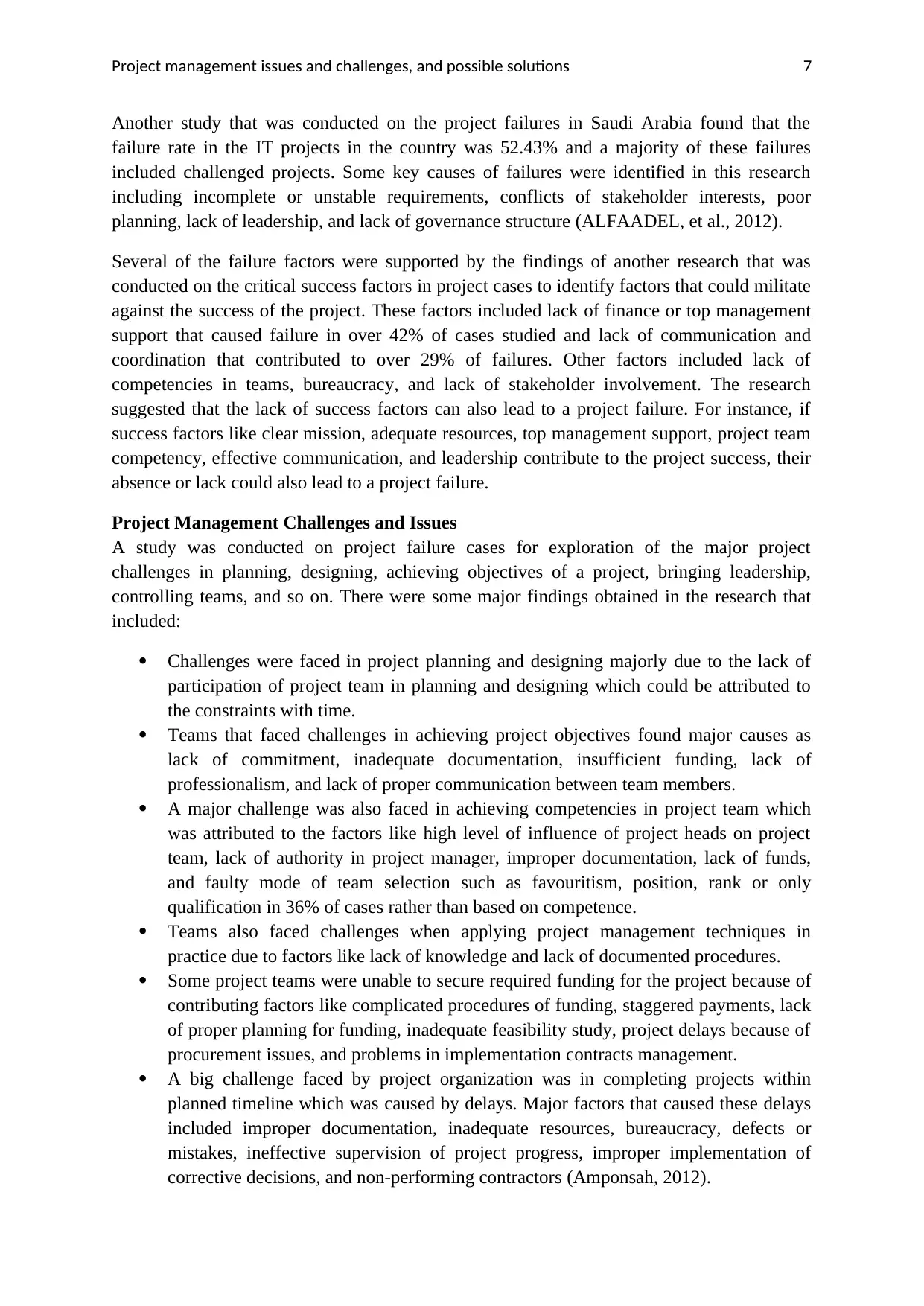
Project management issues and challenges, and possible solutions
Another study that was conducted on the project failures in Saudi Arabia found that the
failure rate in the IT projects in the country was 52.43% and a majority of these failures
included challenged projects. Some key causes of failures were identified in this research
including incomplete or unstable requirements, conflicts of stakeholder interests, poor
planning, lack of leadership, and lack of governance structure (ALFAADEL, et al., 2012).
Several of the failure factors were supported by the findings of another research that was
conducted on the critical success factors in project cases to identify factors that could militate
against the success of the project. These factors included lack of finance or top management
support that caused failure in over 42% of cases studied and lack of communication and
coordination that contributed to over 29% of failures. Other factors included lack of
competencies in teams, bureaucracy, and lack of stakeholder involvement. The research
suggested that the lack of success factors can also lead to a project failure. For instance, if
success factors like clear mission, adequate resources, top management support, project team
competency, effective communication, and leadership contribute to the project success, their
absence or lack could also lead to a project failure.
Project Management Challenges and Issues
A study was conducted on project failure cases for exploration of the major project
challenges in planning, designing, achieving objectives of a project, bringing leadership,
controlling teams, and so on. There were some major findings obtained in the research that
included:
Challenges were faced in project planning and designing majorly due to the lack of
participation of project team in planning and designing which could be attributed to
the constraints with time.
Teams that faced challenges in achieving project objectives found major causes as
lack of commitment, inadequate documentation, insufficient funding, lack of
professionalism, and lack of proper communication between team members.
A major challenge was also faced in achieving competencies in project team which
was attributed to the factors like high level of influence of project heads on project
team, lack of authority in project manager, improper documentation, lack of funds,
and faulty mode of team selection such as favouritism, position, rank or only
qualification in 36% of cases rather than based on competence.
Teams also faced challenges when applying project management techniques in
practice due to factors like lack of knowledge and lack of documented procedures.
Some project teams were unable to secure required funding for the project because of
contributing factors like complicated procedures of funding, staggered payments, lack
of proper planning for funding, inadequate feasibility study, project delays because of
procurement issues, and problems in implementation contracts management.
A big challenge faced by project organization was in completing projects within
planned timeline which was caused by delays. Major factors that caused these delays
included improper documentation, inadequate resources, bureaucracy, defects or
mistakes, ineffective supervision of project progress, improper implementation of
corrective decisions, and non-performing contractors (Amponsah, 2012).
7
Another study that was conducted on the project failures in Saudi Arabia found that the
failure rate in the IT projects in the country was 52.43% and a majority of these failures
included challenged projects. Some key causes of failures were identified in this research
including incomplete or unstable requirements, conflicts of stakeholder interests, poor
planning, lack of leadership, and lack of governance structure (ALFAADEL, et al., 2012).
Several of the failure factors were supported by the findings of another research that was
conducted on the critical success factors in project cases to identify factors that could militate
against the success of the project. These factors included lack of finance or top management
support that caused failure in over 42% of cases studied and lack of communication and
coordination that contributed to over 29% of failures. Other factors included lack of
competencies in teams, bureaucracy, and lack of stakeholder involvement. The research
suggested that the lack of success factors can also lead to a project failure. For instance, if
success factors like clear mission, adequate resources, top management support, project team
competency, effective communication, and leadership contribute to the project success, their
absence or lack could also lead to a project failure.
Project Management Challenges and Issues
A study was conducted on project failure cases for exploration of the major project
challenges in planning, designing, achieving objectives of a project, bringing leadership,
controlling teams, and so on. There were some major findings obtained in the research that
included:
Challenges were faced in project planning and designing majorly due to the lack of
participation of project team in planning and designing which could be attributed to
the constraints with time.
Teams that faced challenges in achieving project objectives found major causes as
lack of commitment, inadequate documentation, insufficient funding, lack of
professionalism, and lack of proper communication between team members.
A major challenge was also faced in achieving competencies in project team which
was attributed to the factors like high level of influence of project heads on project
team, lack of authority in project manager, improper documentation, lack of funds,
and faulty mode of team selection such as favouritism, position, rank or only
qualification in 36% of cases rather than based on competence.
Teams also faced challenges when applying project management techniques in
practice due to factors like lack of knowledge and lack of documented procedures.
Some project teams were unable to secure required funding for the project because of
contributing factors like complicated procedures of funding, staggered payments, lack
of proper planning for funding, inadequate feasibility study, project delays because of
procurement issues, and problems in implementation contracts management.
A big challenge faced by project organization was in completing projects within
planned timeline which was caused by delays. Major factors that caused these delays
included improper documentation, inadequate resources, bureaucracy, defects or
mistakes, ineffective supervision of project progress, improper implementation of
corrective decisions, and non-performing contractors (Amponsah, 2012).
7
Paraphrase This Document
Need a fresh take? Get an instant paraphrase of this document with our AI Paraphraser
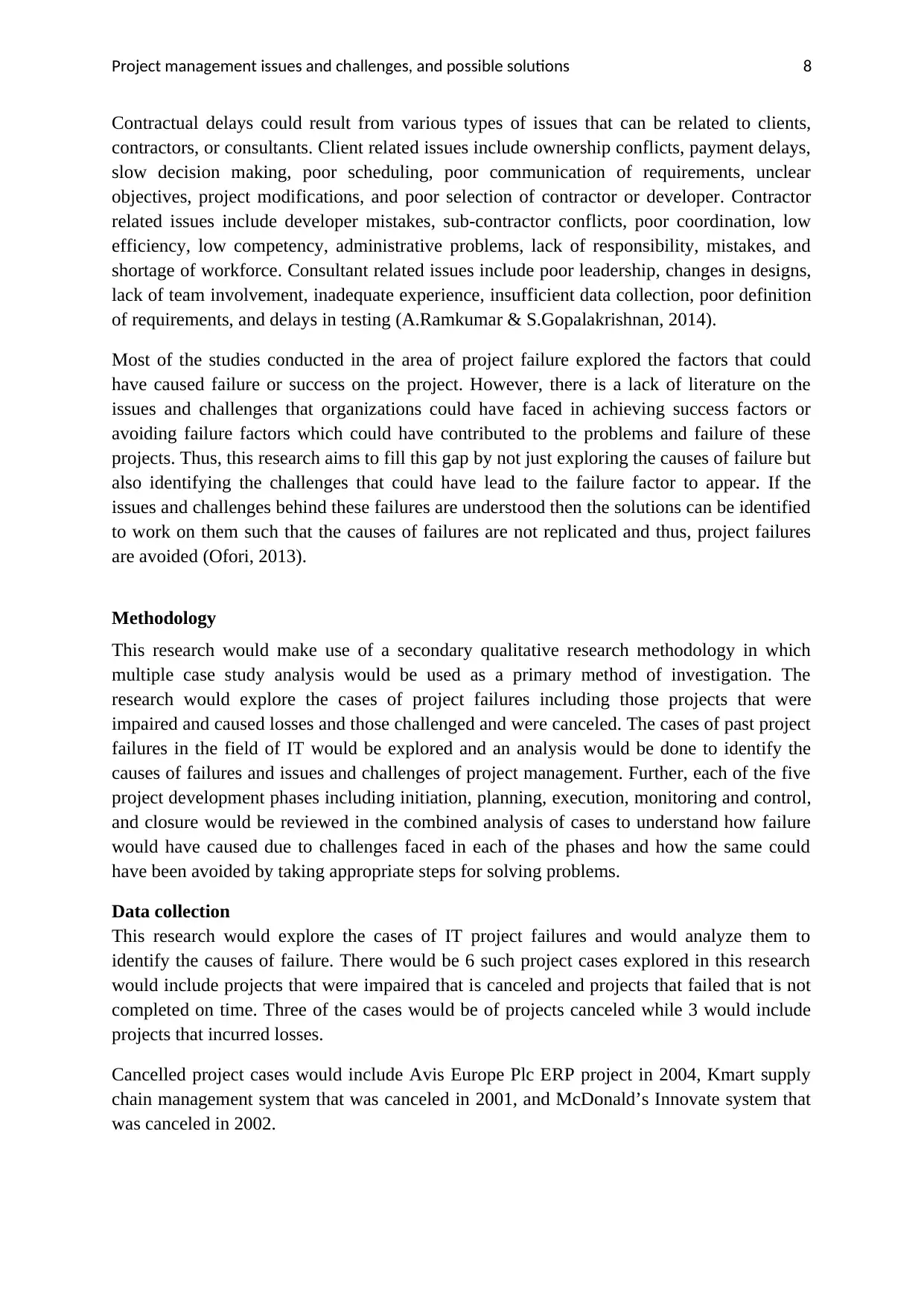
Project management issues and challenges, and possible solutions
Contractual delays could result from various types of issues that can be related to clients,
contractors, or consultants. Client related issues include ownership conflicts, payment delays,
slow decision making, poor scheduling, poor communication of requirements, unclear
objectives, project modifications, and poor selection of contractor or developer. Contractor
related issues include developer mistakes, sub-contractor conflicts, poor coordination, low
efficiency, low competency, administrative problems, lack of responsibility, mistakes, and
shortage of workforce. Consultant related issues include poor leadership, changes in designs,
lack of team involvement, inadequate experience, insufficient data collection, poor definition
of requirements, and delays in testing (A.Ramkumar & S.Gopalakrishnan, 2014).
Most of the studies conducted in the area of project failure explored the factors that could
have caused failure or success on the project. However, there is a lack of literature on the
issues and challenges that organizations could have faced in achieving success factors or
avoiding failure factors which could have contributed to the problems and failure of these
projects. Thus, this research aims to fill this gap by not just exploring the causes of failure but
also identifying the challenges that could have lead to the failure factor to appear. If the
issues and challenges behind these failures are understood then the solutions can be identified
to work on them such that the causes of failures are not replicated and thus, project failures
are avoided (Ofori, 2013).
Methodology
This research would make use of a secondary qualitative research methodology in which
multiple case study analysis would be used as a primary method of investigation. The
research would explore the cases of project failures including those projects that were
impaired and caused losses and those challenged and were canceled. The cases of past project
failures in the field of IT would be explored and an analysis would be done to identify the
causes of failures and issues and challenges of project management. Further, each of the five
project development phases including initiation, planning, execution, monitoring and control,
and closure would be reviewed in the combined analysis of cases to understand how failure
would have caused due to challenges faced in each of the phases and how the same could
have been avoided by taking appropriate steps for solving problems.
Data collection
This research would explore the cases of IT project failures and would analyze them to
identify the causes of failure. There would be 6 such project cases explored in this research
would include projects that were impaired that is canceled and projects that failed that is not
completed on time. Three of the cases would be of projects canceled while 3 would include
projects that incurred losses.
Cancelled project cases would include Avis Europe Plc ERP project in 2004, Kmart supply
chain management system that was canceled in 2001, and McDonald’s Innovate system that
was canceled in 2002.
8
Contractual delays could result from various types of issues that can be related to clients,
contractors, or consultants. Client related issues include ownership conflicts, payment delays,
slow decision making, poor scheduling, poor communication of requirements, unclear
objectives, project modifications, and poor selection of contractor or developer. Contractor
related issues include developer mistakes, sub-contractor conflicts, poor coordination, low
efficiency, low competency, administrative problems, lack of responsibility, mistakes, and
shortage of workforce. Consultant related issues include poor leadership, changes in designs,
lack of team involvement, inadequate experience, insufficient data collection, poor definition
of requirements, and delays in testing (A.Ramkumar & S.Gopalakrishnan, 2014).
Most of the studies conducted in the area of project failure explored the factors that could
have caused failure or success on the project. However, there is a lack of literature on the
issues and challenges that organizations could have faced in achieving success factors or
avoiding failure factors which could have contributed to the problems and failure of these
projects. Thus, this research aims to fill this gap by not just exploring the causes of failure but
also identifying the challenges that could have lead to the failure factor to appear. If the
issues and challenges behind these failures are understood then the solutions can be identified
to work on them such that the causes of failures are not replicated and thus, project failures
are avoided (Ofori, 2013).
Methodology
This research would make use of a secondary qualitative research methodology in which
multiple case study analysis would be used as a primary method of investigation. The
research would explore the cases of project failures including those projects that were
impaired and caused losses and those challenged and were canceled. The cases of past project
failures in the field of IT would be explored and an analysis would be done to identify the
causes of failures and issues and challenges of project management. Further, each of the five
project development phases including initiation, planning, execution, monitoring and control,
and closure would be reviewed in the combined analysis of cases to understand how failure
would have caused due to challenges faced in each of the phases and how the same could
have been avoided by taking appropriate steps for solving problems.
Data collection
This research would explore the cases of IT project failures and would analyze them to
identify the causes of failure. There would be 6 such project cases explored in this research
would include projects that were impaired that is canceled and projects that failed that is not
completed on time. Three of the cases would be of projects canceled while 3 would include
projects that incurred losses.
Cancelled project cases would include Avis Europe Plc ERP project in 2004, Kmart supply
chain management system that was canceled in 2001, and McDonald’s Innovate system that
was canceled in 2002.
8
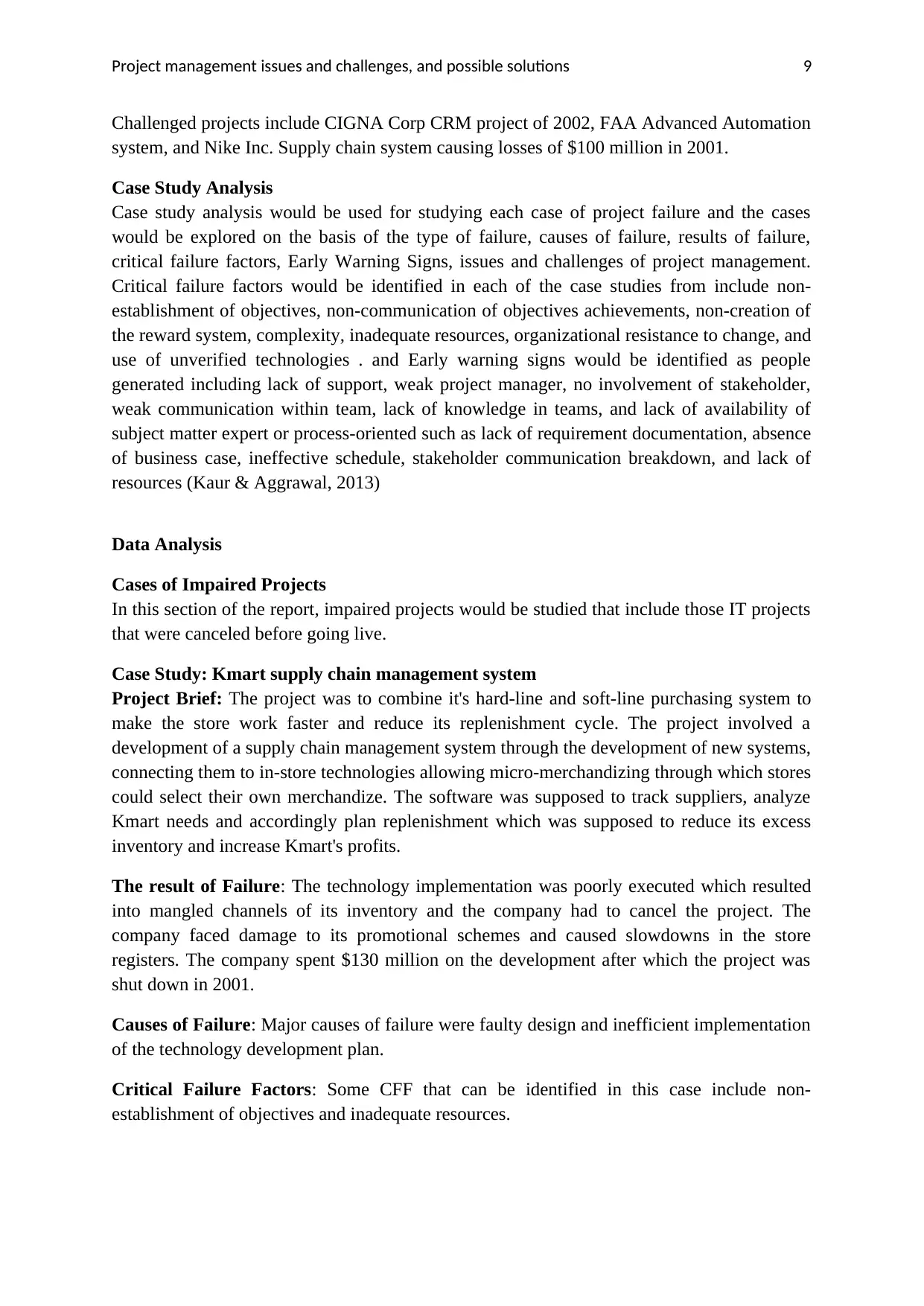
Project management issues and challenges, and possible solutions
Challenged projects include CIGNA Corp CRM project of 2002, FAA Advanced Automation
system, and Nike Inc. Supply chain system causing losses of $100 million in 2001.
Case Study Analysis
Case study analysis would be used for studying each case of project failure and the cases
would be explored on the basis of the type of failure, causes of failure, results of failure,
critical failure factors, Early Warning Signs, issues and challenges of project management.
Critical failure factors would be identified in each of the case studies from include non-
establishment of objectives, non-communication of objectives achievements, non-creation of
the reward system, complexity, inadequate resources, organizational resistance to change, and
use of unverified technologies . and Early warning signs would be identified as people
generated including lack of support, weak project manager, no involvement of stakeholder,
weak communication within team, lack of knowledge in teams, and lack of availability of
subject matter expert or process-oriented such as lack of requirement documentation, absence
of business case, ineffective schedule, stakeholder communication breakdown, and lack of
resources (Kaur & Aggrawal, 2013)
Data Analysis
Cases of Impaired Projects
In this section of the report, impaired projects would be studied that include those IT projects
that were canceled before going live.
Case Study: Kmart supply chain management system
Project Brief: The project was to combine it's hard-line and soft-line purchasing system to
make the store work faster and reduce its replenishment cycle. The project involved a
development of a supply chain management system through the development of new systems,
connecting them to in-store technologies allowing micro-merchandizing through which stores
could select their own merchandize. The software was supposed to track suppliers, analyze
Kmart needs and accordingly plan replenishment which was supposed to reduce its excess
inventory and increase Kmart's profits.
The result of Failure: The technology implementation was poorly executed which resulted
into mangled channels of its inventory and the company had to cancel the project. The
company faced damage to its promotional schemes and caused slowdowns in the store
registers. The company spent $130 million on the development after which the project was
shut down in 2001.
Causes of Failure: Major causes of failure were faulty design and inefficient implementation
of the technology development plan.
Critical Failure Factors: Some CFF that can be identified in this case include non-
establishment of objectives and inadequate resources.
9
Challenged projects include CIGNA Corp CRM project of 2002, FAA Advanced Automation
system, and Nike Inc. Supply chain system causing losses of $100 million in 2001.
Case Study Analysis
Case study analysis would be used for studying each case of project failure and the cases
would be explored on the basis of the type of failure, causes of failure, results of failure,
critical failure factors, Early Warning Signs, issues and challenges of project management.
Critical failure factors would be identified in each of the case studies from include non-
establishment of objectives, non-communication of objectives achievements, non-creation of
the reward system, complexity, inadequate resources, organizational resistance to change, and
use of unverified technologies . and Early warning signs would be identified as people
generated including lack of support, weak project manager, no involvement of stakeholder,
weak communication within team, lack of knowledge in teams, and lack of availability of
subject matter expert or process-oriented such as lack of requirement documentation, absence
of business case, ineffective schedule, stakeholder communication breakdown, and lack of
resources (Kaur & Aggrawal, 2013)
Data Analysis
Cases of Impaired Projects
In this section of the report, impaired projects would be studied that include those IT projects
that were canceled before going live.
Case Study: Kmart supply chain management system
Project Brief: The project was to combine it's hard-line and soft-line purchasing system to
make the store work faster and reduce its replenishment cycle. The project involved a
development of a supply chain management system through the development of new systems,
connecting them to in-store technologies allowing micro-merchandizing through which stores
could select their own merchandize. The software was supposed to track suppliers, analyze
Kmart needs and accordingly plan replenishment which was supposed to reduce its excess
inventory and increase Kmart's profits.
The result of Failure: The technology implementation was poorly executed which resulted
into mangled channels of its inventory and the company had to cancel the project. The
company faced damage to its promotional schemes and caused slowdowns in the store
registers. The company spent $130 million on the development after which the project was
shut down in 2001.
Causes of Failure: Major causes of failure were faulty design and inefficient implementation
of the technology development plan.
Critical Failure Factors: Some CFF that can be identified in this case include non-
establishment of objectives and inadequate resources.
9
⊘ This is a preview!⊘
Do you want full access?
Subscribe today to unlock all pages.

Trusted by 1+ million students worldwide
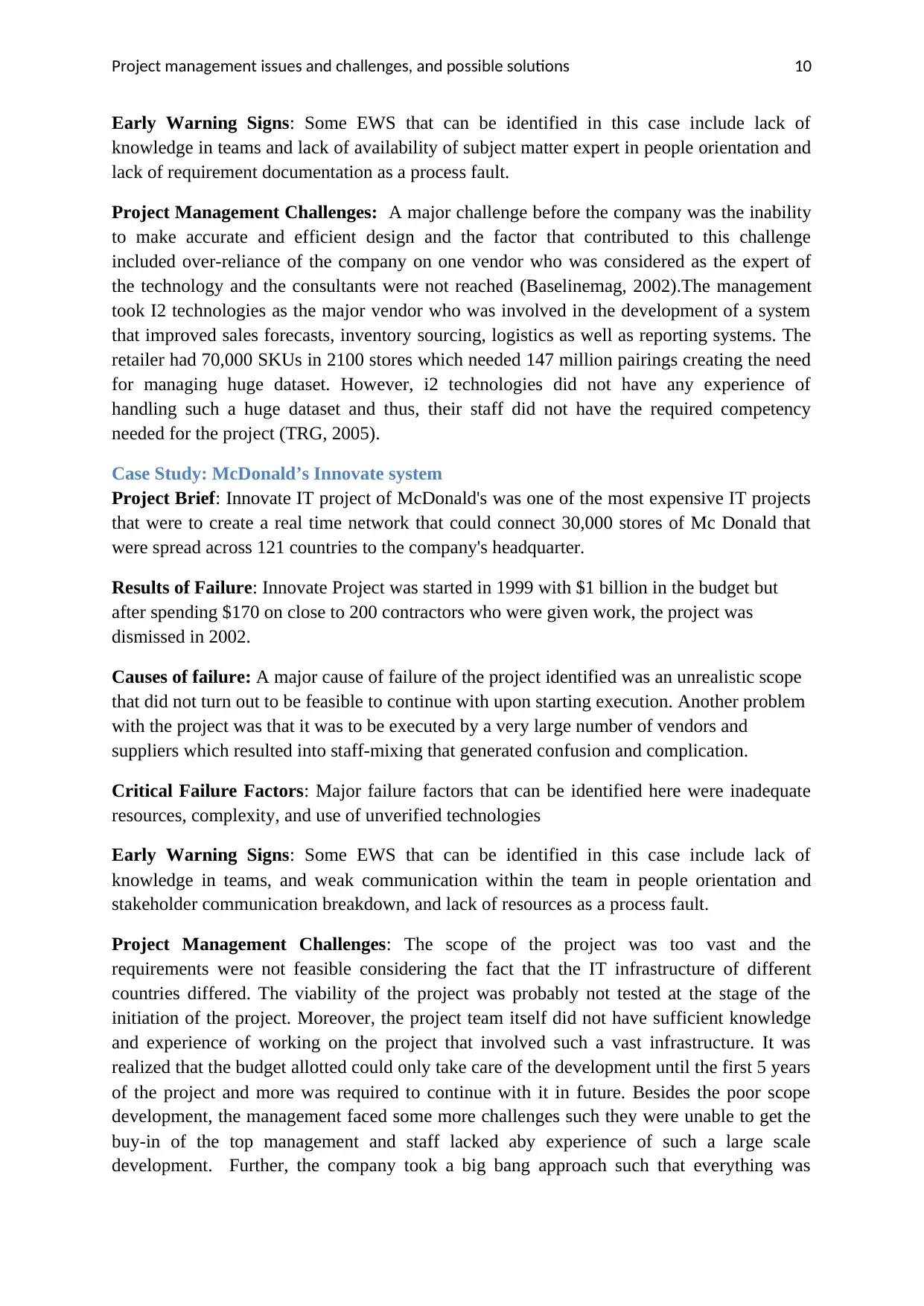
Project management issues and challenges, and possible solutions
Early Warning Signs: Some EWS that can be identified in this case include lack of
knowledge in teams and lack of availability of subject matter expert in people orientation and
lack of requirement documentation as a process fault.
Project Management Challenges: A major challenge before the company was the inability
to make accurate and efficient design and the factor that contributed to this challenge
included over-reliance of the company on one vendor who was considered as the expert of
the technology and the consultants were not reached (Baselinemag, 2002).The management
took I2 technologies as the major vendor who was involved in the development of a system
that improved sales forecasts, inventory sourcing, logistics as well as reporting systems. The
retailer had 70,000 SKUs in 2100 stores which needed 147 million pairings creating the need
for managing huge dataset. However, i2 technologies did not have any experience of
handling such a huge dataset and thus, their staff did not have the required competency
needed for the project (TRG, 2005).
Case Study: McDonald’s Innovate system
Project Brief: Innovate IT project of McDonald's was one of the most expensive IT projects
that were to create a real time network that could connect 30,000 stores of Mc Donald that
were spread across 121 countries to the company's headquarter.
Results of Failure: Innovate Project was started in 1999 with $1 billion in the budget but
after spending $170 on close to 200 contractors who were given work, the project was
dismissed in 2002.
Causes of failure: A major cause of failure of the project identified was an unrealistic scope
that did not turn out to be feasible to continue with upon starting execution. Another problem
with the project was that it was to be executed by a very large number of vendors and
suppliers which resulted into staff-mixing that generated confusion and complication.
Critical Failure Factors: Major failure factors that can be identified here were inadequate
resources, complexity, and use of unverified technologies
Early Warning Signs: Some EWS that can be identified in this case include lack of
knowledge in teams, and weak communication within the team in people orientation and
stakeholder communication breakdown, and lack of resources as a process fault.
Project Management Challenges: The scope of the project was too vast and the
requirements were not feasible considering the fact that the IT infrastructure of different
countries differed. The viability of the project was probably not tested at the stage of the
initiation of the project. Moreover, the project team itself did not have sufficient knowledge
and experience of working on the project that involved such a vast infrastructure. It was
realized that the budget allotted could only take care of the development until the first 5 years
of the project and more was required to continue with it in future. Besides the poor scope
development, the management faced some more challenges such they were unable to get the
buy-in of the top management and staff lacked aby experience of such a large scale
development. Further, the company took a big bang approach such that everything was
10
Early Warning Signs: Some EWS that can be identified in this case include lack of
knowledge in teams and lack of availability of subject matter expert in people orientation and
lack of requirement documentation as a process fault.
Project Management Challenges: A major challenge before the company was the inability
to make accurate and efficient design and the factor that contributed to this challenge
included over-reliance of the company on one vendor who was considered as the expert of
the technology and the consultants were not reached (Baselinemag, 2002).The management
took I2 technologies as the major vendor who was involved in the development of a system
that improved sales forecasts, inventory sourcing, logistics as well as reporting systems. The
retailer had 70,000 SKUs in 2100 stores which needed 147 million pairings creating the need
for managing huge dataset. However, i2 technologies did not have any experience of
handling such a huge dataset and thus, their staff did not have the required competency
needed for the project (TRG, 2005).
Case Study: McDonald’s Innovate system
Project Brief: Innovate IT project of McDonald's was one of the most expensive IT projects
that were to create a real time network that could connect 30,000 stores of Mc Donald that
were spread across 121 countries to the company's headquarter.
Results of Failure: Innovate Project was started in 1999 with $1 billion in the budget but
after spending $170 on close to 200 contractors who were given work, the project was
dismissed in 2002.
Causes of failure: A major cause of failure of the project identified was an unrealistic scope
that did not turn out to be feasible to continue with upon starting execution. Another problem
with the project was that it was to be executed by a very large number of vendors and
suppliers which resulted into staff-mixing that generated confusion and complication.
Critical Failure Factors: Major failure factors that can be identified here were inadequate
resources, complexity, and use of unverified technologies
Early Warning Signs: Some EWS that can be identified in this case include lack of
knowledge in teams, and weak communication within the team in people orientation and
stakeholder communication breakdown, and lack of resources as a process fault.
Project Management Challenges: The scope of the project was too vast and the
requirements were not feasible considering the fact that the IT infrastructure of different
countries differed. The viability of the project was probably not tested at the stage of the
initiation of the project. Moreover, the project team itself did not have sufficient knowledge
and experience of working on the project that involved such a vast infrastructure. It was
realized that the budget allotted could only take care of the development until the first 5 years
of the project and more was required to continue with it in future. Besides the poor scope
development, the management faced some more challenges such they were unable to get the
buy-in of the top management and staff lacked aby experience of such a large scale
development. Further, the company took a big bang approach such that everything was
10
Paraphrase This Document
Need a fresh take? Get an instant paraphrase of this document with our AI Paraphraser
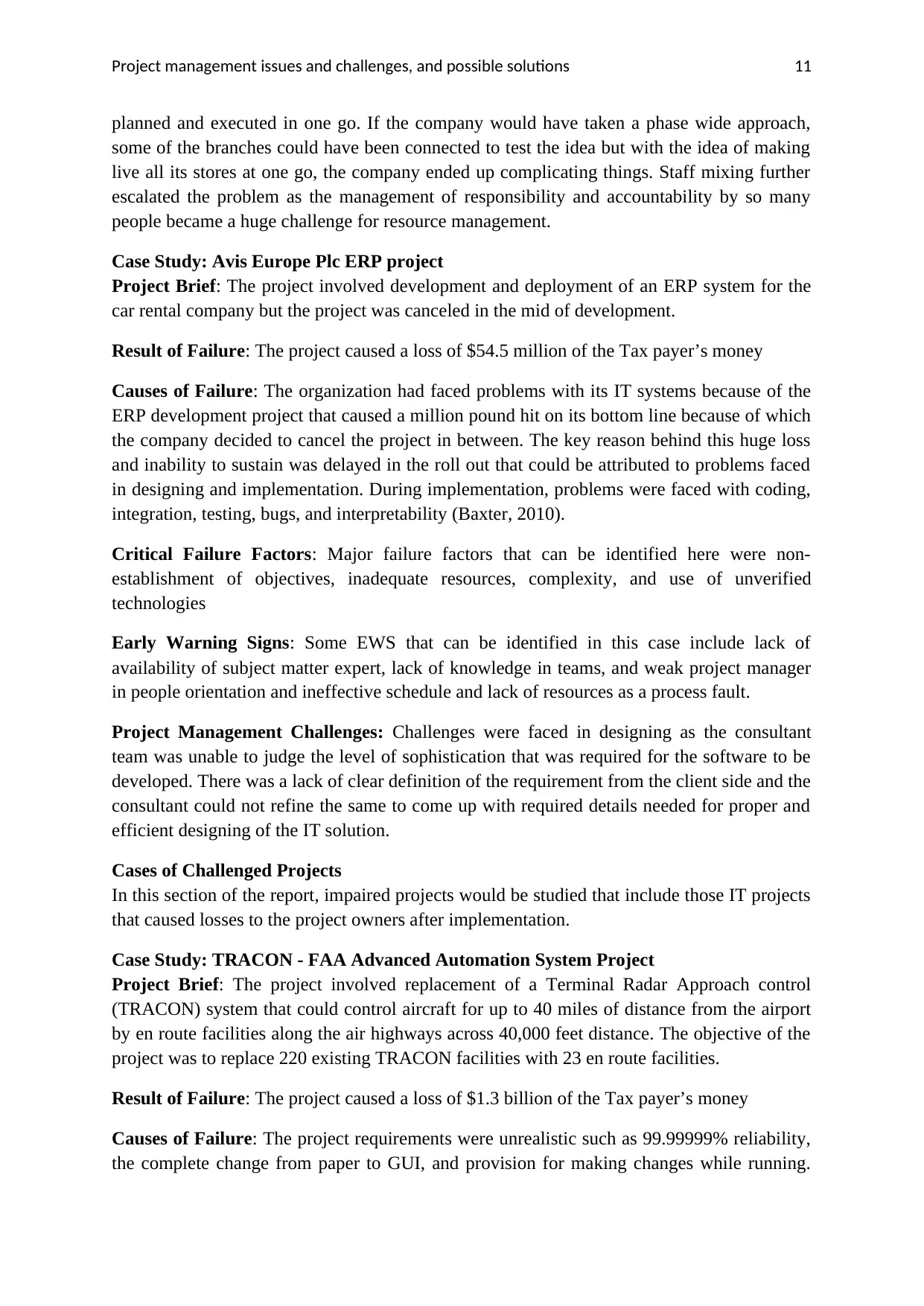
Project management issues and challenges, and possible solutions
planned and executed in one go. If the company would have taken a phase wide approach,
some of the branches could have been connected to test the idea but with the idea of making
live all its stores at one go, the company ended up complicating things. Staff mixing further
escalated the problem as the management of responsibility and accountability by so many
people became a huge challenge for resource management.
Case Study: Avis Europe Plc ERP project
Project Brief: The project involved development and deployment of an ERP system for the
car rental company but the project was canceled in the mid of development.
Result of Failure: The project caused a loss of $54.5 million of the Tax payer’s money
Causes of Failure: The organization had faced problems with its IT systems because of the
ERP development project that caused a million pound hit on its bottom line because of which
the company decided to cancel the project in between. The key reason behind this huge loss
and inability to sustain was delayed in the roll out that could be attributed to problems faced
in designing and implementation. During implementation, problems were faced with coding,
integration, testing, bugs, and interpretability (Baxter, 2010).
Critical Failure Factors: Major failure factors that can be identified here were non-
establishment of objectives, inadequate resources, complexity, and use of unverified
technologies
Early Warning Signs: Some EWS that can be identified in this case include lack of
availability of subject matter expert, lack of knowledge in teams, and weak project manager
in people orientation and ineffective schedule and lack of resources as a process fault.
Project Management Challenges: Challenges were faced in designing as the consultant
team was unable to judge the level of sophistication that was required for the software to be
developed. There was a lack of clear definition of the requirement from the client side and the
consultant could not refine the same to come up with required details needed for proper and
efficient designing of the IT solution.
Cases of Challenged Projects
In this section of the report, impaired projects would be studied that include those IT projects
that caused losses to the project owners after implementation.
Case Study: TRACON - FAA Advanced Automation System Project
Project Brief: The project involved replacement of a Terminal Radar Approach control
(TRACON) system that could control aircraft for up to 40 miles of distance from the airport
by en route facilities along the air highways across 40,000 feet distance. The objective of the
project was to replace 220 existing TRACON facilities with 23 en route facilities.
Result of Failure: The project caused a loss of $1.3 billion of the Tax payer’s money
Causes of Failure: The project requirements were unrealistic such as 99.99999% reliability,
the complete change from paper to GUI, and provision for making changes while running.
11
planned and executed in one go. If the company would have taken a phase wide approach,
some of the branches could have been connected to test the idea but with the idea of making
live all its stores at one go, the company ended up complicating things. Staff mixing further
escalated the problem as the management of responsibility and accountability by so many
people became a huge challenge for resource management.
Case Study: Avis Europe Plc ERP project
Project Brief: The project involved development and deployment of an ERP system for the
car rental company but the project was canceled in the mid of development.
Result of Failure: The project caused a loss of $54.5 million of the Tax payer’s money
Causes of Failure: The organization had faced problems with its IT systems because of the
ERP development project that caused a million pound hit on its bottom line because of which
the company decided to cancel the project in between. The key reason behind this huge loss
and inability to sustain was delayed in the roll out that could be attributed to problems faced
in designing and implementation. During implementation, problems were faced with coding,
integration, testing, bugs, and interpretability (Baxter, 2010).
Critical Failure Factors: Major failure factors that can be identified here were non-
establishment of objectives, inadequate resources, complexity, and use of unverified
technologies
Early Warning Signs: Some EWS that can be identified in this case include lack of
availability of subject matter expert, lack of knowledge in teams, and weak project manager
in people orientation and ineffective schedule and lack of resources as a process fault.
Project Management Challenges: Challenges were faced in designing as the consultant
team was unable to judge the level of sophistication that was required for the software to be
developed. There was a lack of clear definition of the requirement from the client side and the
consultant could not refine the same to come up with required details needed for proper and
efficient designing of the IT solution.
Cases of Challenged Projects
In this section of the report, impaired projects would be studied that include those IT projects
that caused losses to the project owners after implementation.
Case Study: TRACON - FAA Advanced Automation System Project
Project Brief: The project involved replacement of a Terminal Radar Approach control
(TRACON) system that could control aircraft for up to 40 miles of distance from the airport
by en route facilities along the air highways across 40,000 feet distance. The objective of the
project was to replace 220 existing TRACON facilities with 23 en route facilities.
Result of Failure: The project caused a loss of $1.3 billion of the Tax payer’s money
Causes of Failure: The project requirements were unrealistic such as 99.99999% reliability,
the complete change from paper to GUI, and provision for making changes while running.
11
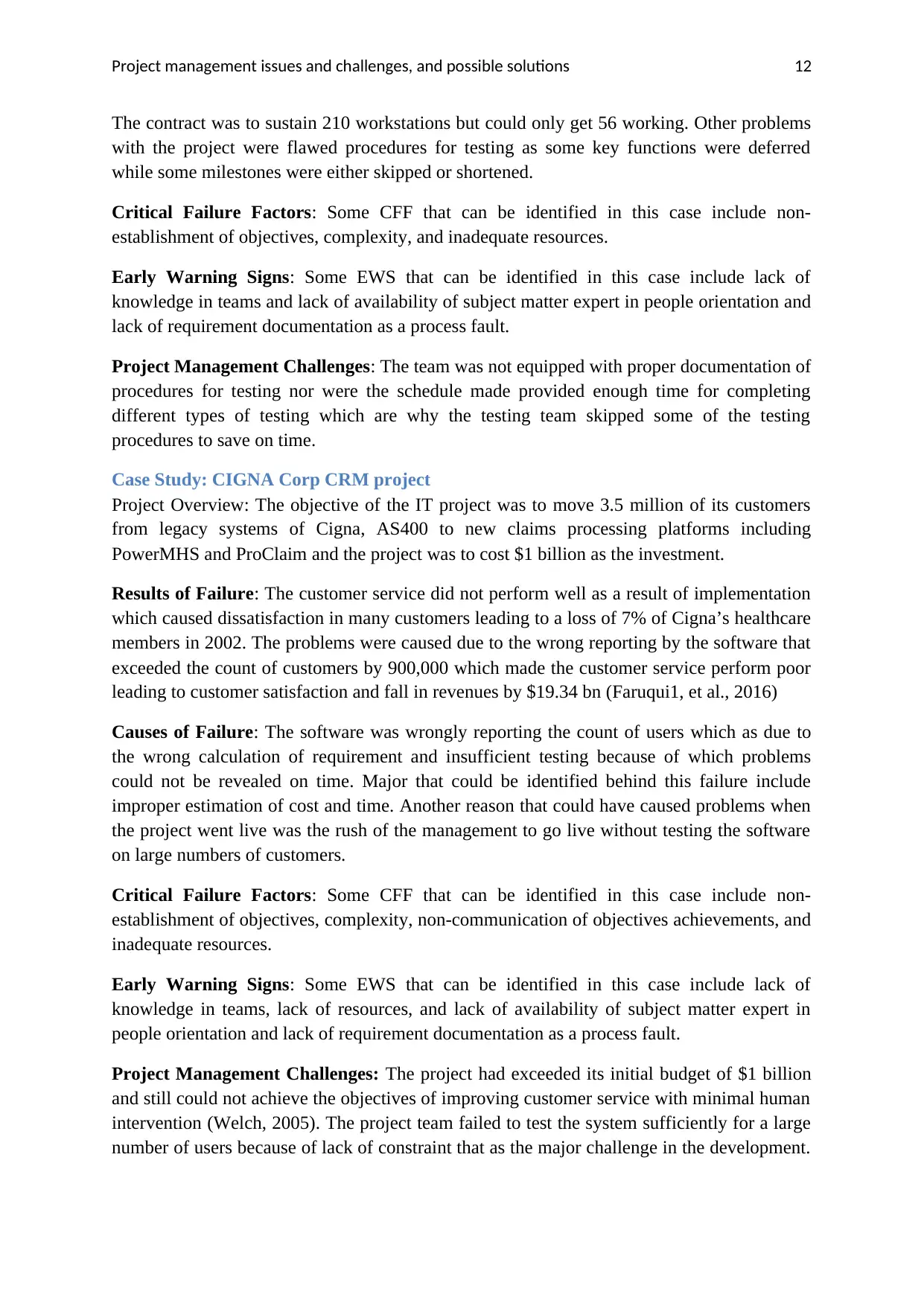
Project management issues and challenges, and possible solutions
The contract was to sustain 210 workstations but could only get 56 working. Other problems
with the project were flawed procedures for testing as some key functions were deferred
while some milestones were either skipped or shortened.
Critical Failure Factors: Some CFF that can be identified in this case include non-
establishment of objectives, complexity, and inadequate resources.
Early Warning Signs: Some EWS that can be identified in this case include lack of
knowledge in teams and lack of availability of subject matter expert in people orientation and
lack of requirement documentation as a process fault.
Project Management Challenges: The team was not equipped with proper documentation of
procedures for testing nor were the schedule made provided enough time for completing
different types of testing which are why the testing team skipped some of the testing
procedures to save on time.
Case Study: CIGNA Corp CRM project
Project Overview: The objective of the IT project was to move 3.5 million of its customers
from legacy systems of Cigna, AS400 to new claims processing platforms including
PowerMHS and ProClaim and the project was to cost $1 billion as the investment.
Results of Failure: The customer service did not perform well as a result of implementation
which caused dissatisfaction in many customers leading to a loss of 7% of Cigna’s healthcare
members in 2002. The problems were caused due to the wrong reporting by the software that
exceeded the count of customers by 900,000 which made the customer service perform poor
leading to customer satisfaction and fall in revenues by $19.34 bn (Faruqui1, et al., 2016)
Causes of Failure: The software was wrongly reporting the count of users which as due to
the wrong calculation of requirement and insufficient testing because of which problems
could not be revealed on time. Major that could be identified behind this failure include
improper estimation of cost and time. Another reason that could have caused problems when
the project went live was the rush of the management to go live without testing the software
on large numbers of customers.
Critical Failure Factors: Some CFF that can be identified in this case include non-
establishment of objectives, complexity, non-communication of objectives achievements, and
inadequate resources.
Early Warning Signs: Some EWS that can be identified in this case include lack of
knowledge in teams, lack of resources, and lack of availability of subject matter expert in
people orientation and lack of requirement documentation as a process fault.
Project Management Challenges: The project had exceeded its initial budget of $1 billion
and still could not achieve the objectives of improving customer service with minimal human
intervention (Welch, 2005). The project team failed to test the system sufficiently for a large
number of users because of lack of constraint that as the major challenge in the development.
12
The contract was to sustain 210 workstations but could only get 56 working. Other problems
with the project were flawed procedures for testing as some key functions were deferred
while some milestones were either skipped or shortened.
Critical Failure Factors: Some CFF that can be identified in this case include non-
establishment of objectives, complexity, and inadequate resources.
Early Warning Signs: Some EWS that can be identified in this case include lack of
knowledge in teams and lack of availability of subject matter expert in people orientation and
lack of requirement documentation as a process fault.
Project Management Challenges: The team was not equipped with proper documentation of
procedures for testing nor were the schedule made provided enough time for completing
different types of testing which are why the testing team skipped some of the testing
procedures to save on time.
Case Study: CIGNA Corp CRM project
Project Overview: The objective of the IT project was to move 3.5 million of its customers
from legacy systems of Cigna, AS400 to new claims processing platforms including
PowerMHS and ProClaim and the project was to cost $1 billion as the investment.
Results of Failure: The customer service did not perform well as a result of implementation
which caused dissatisfaction in many customers leading to a loss of 7% of Cigna’s healthcare
members in 2002. The problems were caused due to the wrong reporting by the software that
exceeded the count of customers by 900,000 which made the customer service perform poor
leading to customer satisfaction and fall in revenues by $19.34 bn (Faruqui1, et al., 2016)
Causes of Failure: The software was wrongly reporting the count of users which as due to
the wrong calculation of requirement and insufficient testing because of which problems
could not be revealed on time. Major that could be identified behind this failure include
improper estimation of cost and time. Another reason that could have caused problems when
the project went live was the rush of the management to go live without testing the software
on large numbers of customers.
Critical Failure Factors: Some CFF that can be identified in this case include non-
establishment of objectives, complexity, non-communication of objectives achievements, and
inadequate resources.
Early Warning Signs: Some EWS that can be identified in this case include lack of
knowledge in teams, lack of resources, and lack of availability of subject matter expert in
people orientation and lack of requirement documentation as a process fault.
Project Management Challenges: The project had exceeded its initial budget of $1 billion
and still could not achieve the objectives of improving customer service with minimal human
intervention (Welch, 2005). The project team failed to test the system sufficiently for a large
number of users because of lack of constraint that as the major challenge in the development.
12
⊘ This is a preview!⊘
Do you want full access?
Subscribe today to unlock all pages.

Trusted by 1+ million students worldwide
1 out of 16
Related Documents
Your All-in-One AI-Powered Toolkit for Academic Success.
+13062052269
info@desklib.com
Available 24*7 on WhatsApp / Email
![[object Object]](/_next/static/media/star-bottom.7253800d.svg)
Unlock your academic potential
Copyright © 2020–2025 A2Z Services. All Rights Reserved. Developed and managed by ZUCOL.





